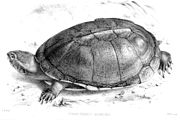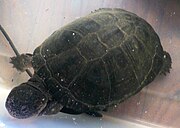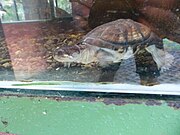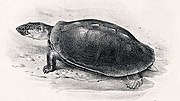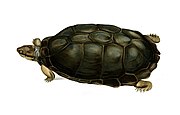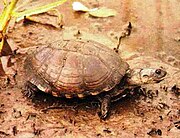
Pelomedusidae is a family of freshwater turtles endemic to sub-Saharan Africa, including Madagascar, São Tomé, and the Seychelles. They range in size from 12 to 45 cm in carapace length, and are generally roundish in shape. They are unable to fully withdraw their heads into their shells, instead drawing them to the side and folding them beneath the upper edge of their shells, hence are called African side-necked turtles.

Macrochelys is a genus of very large freshwater turtles in the family Chelydridae, native to the Southeastern and Midwestern United States. Only a single extant species was recognized until 2014, when a study divided it into two, or possibly three species. These turtles are easily recognized by three distinct dorsal ridges with raised spikes.

The big-headed pantanal swamp turtle or pantanal swamp turtle is a species of turtle in the family Chelidae found in Brazil, Bolivia, Argentina, and Paraguay.

The New Guinea snake-necked turtle is a species of turtle in the family Chelidae. The species is found almost exclusively within Western Province, Papua New Guinea.
Pelusios broadleyi, commonly known as the Turkana mud turtle, Broadley's mud turtle, or the Lake Turkana hinged terrapin, is a species of turtle in the family Pelomedusidae. The species is native to eastern Africa.
The variable mud turtle, also known as Rhodesian mud turtle, Mashona hinged terrapin or variable hinged terrapin, is a species of turtle in the family Pelomedusidae. It is widely distributed in Central, East, and Southern Africa. The species was officially described by John Hewitt in 1927 and had to be broken into subspecies due to color variations on the heads of the turtles acrost the regions.

The East African black mud turtle, also known as the Pan terrapin, is a species of turtle in the family Pelomedusidae, native to eastern and southeastern Africa.
Dahl's toad-headed turtle is a medium-sized species of side-necked turtle in the family Chelidae. This critically endangered freshwater turtle is endemic to northern Colombia, where it lives in small pools, streams, and swamps, but aestivates on land.

Cyclemys is a genus of freshwater turtles, commonly referred to as Asian leaf turtles, from the family Geoemydidae. The genus occurs throughout Southeast and South Asia, and currently contains seven species.
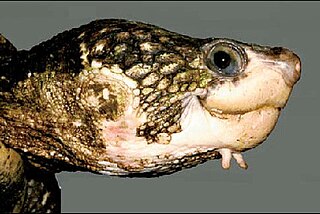
Elseya albagula, commonly known as the white-throated snapping turtle, is one of the largest species of chelid turtles in the world, growing to about 45 cm (18 in) carapace length.
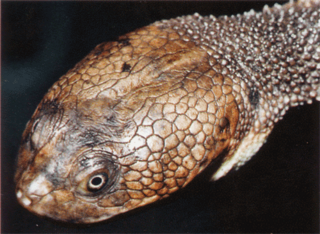
Chelodina canni, also known commonly as Cann's snake-necked turtle, is a species of turtle in the family Chelidae. The species is endemic to Australia, where it is found in the northern and northeastern parts of the continent. It has a narrow zone of hybridization with its related species the eastern snake-necked turtle, C. longicollis. For many years C. canni was assumed to be the same species as C. novaeguineae from New Guinea. However, in 2002 it was shown that these two species differ both morphologically and genetically, and therefore C. canni was separated and described as a unique species.

Chelodina (Chelydera) burrungandjii, the sandstone snake-necked turtle or Arnhem Land long-necked turtle, is a medium-sized turtle reaching carapace lengths of 316 mm. The species is found in the sandstone plateaus and escarpments and the plunge pools of Arnhem Land of the Northern Territory. The species had been long recognised as valid. However, it had been difficult to research due to the remoteness of its habitat. Efforts to breed this species in captivity had been largely unsuccessful, until National Aquarium Herpetologist Matthew Benedict lead a successful breeding project in 2021. The species occurs in proximity to Chelodina rugosa, to which it is closely related. For the most part the two species are parapatric in distribution. However, they do come together in limited locations such as plunge pools at the base of the escarpments. In these areas there is hybridization between the species.

The Assam leaf turtle is a species of turtle in the family Geoemydidae. The species is native to India, Nepal, Bhutan, and Bangladesh.

Cyclemys enigmatica, also known as the enigmatic leaf turtle, is a species of Asian leaf turtle. It is found in the Greater Sunda Islands and the Malay Peninsula.

The western black-bridged leaf turtle is a species of Asian leaf turtle found in southern Indochina.

The eastern black-bridged leaf turtle is a species of Asian leaf turtles found in southern Indochina.

The West African mud turtle, also known as the West African side-necked turtle or swamp terrapin, is a species of turtle in the family Pelomedusidae. Pelusios castaneus is a freshwater species and is endemic to West and Central Africa.

Adanson's mud turtle is a species of turtle in the family Pelomedusidae. The species is endemic to north-central Africa.

The Okavango mud turtle or Okavango terrapin) is a species of turtle in the family Pelomedusidae endemic to Africa. It is found in Angola, Botswana, the Democratic Republic of the Congo, Namibia (Caprivi), Zambia, and Zimbabwe.

The African forest turtle is a species of turtle in the family Pelomedusidae. It is endemic to Africa, where it can be found in Angola, Burundi, Cameroon, Equatorial Guinea, Gabon, the Democratic Republic of the Congo, the Republic of the Congo, Ghana, Tanzania, and Uganda

